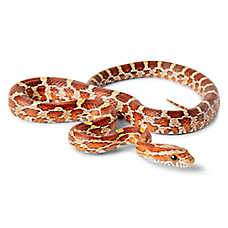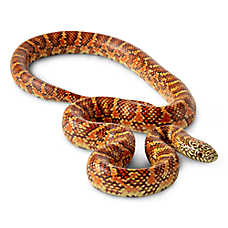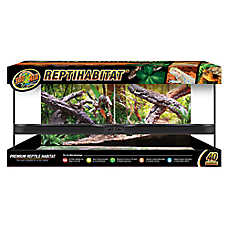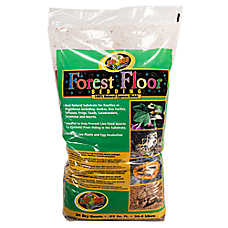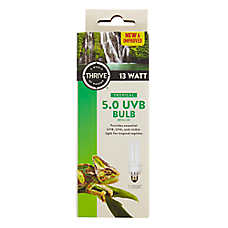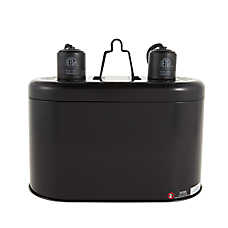Milk, King and Corn Snake Care Guide
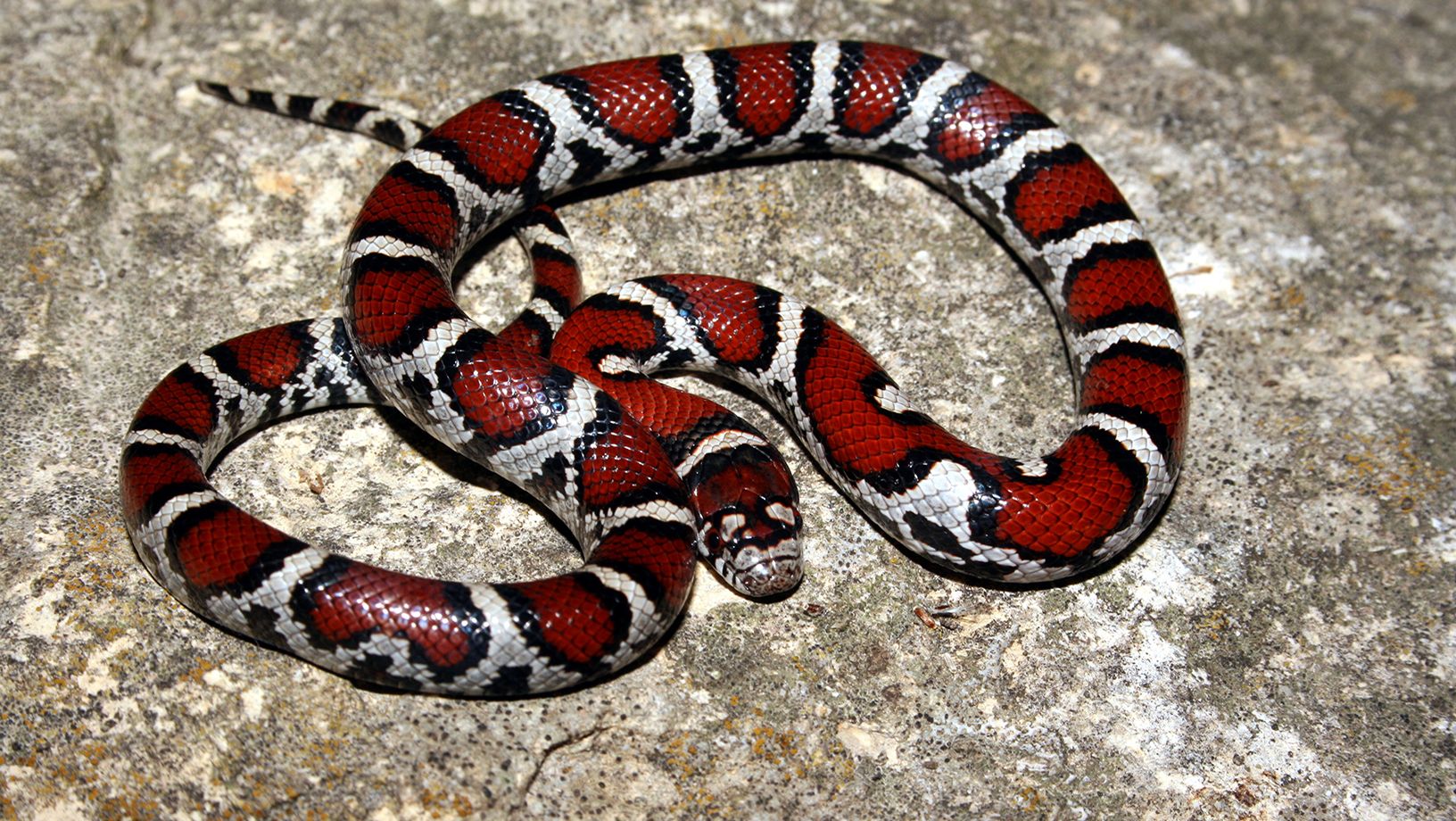
In this Article
Milk snakes and King snakes and Corn snakes, oh my!
Milk snakes, king snakes, and corn snakes might look different, but they share very similar care needs. That’s why these three species are often grouped together as colubrids, a family of non-venomous, ground-dwelling snakes common across North America. These snakes come in a wide variety of colors and patterns, known as morphs, and are often recommended for beginner to intermediate reptile keepers thanks to their manageable size and generally calm temperaments.
- Experience level: beginner to intermediate
- Size: King and corn snakes grow to 48-60" (122-152 cm), milk snakes grow to 24-60" (61-152 cm).
- Lifespan: These types of snakes live for approximately 18-23 years
- Behavior: These snakes tend to be more active in the evening and night, so try not to disturb them too much during the day. These varieties of snake are not known for coiling up around your hand/arm like their python cousins, and instead tend to be pretty mobile. Luckily, they are easy to direct by gently guiding their head the direction you want them to go.
- Temperament: As they become more comfortable with you, these snakes are typically easy to handle and are stereotypically docile animals. All 3 varieties of snake prefer to be alone and should be housed individually.
Note: A frightened snake may lash with its tail, hiss or in rare cases, bite. While milk, king, and corn snakes are not venomous, due to the nature of eating raw meat, any bite should be thoroughly cleaned, and medical attention may be warranted.
How to set up a colubrid habitat
Creating a proper environment is key to keeping your milk, king, or corn snake healthy. These snakes are notorious escape artists, so every habitat setup should balance security, temperature control, and enrichment.
Enclosure size and substrate
- Choose a terrarium that’s at least two-thirds the length of your snake. The specific size of terrarium you need may change as your snake grows.
- Make sure the enclosure has a secure screen lid with strong clips or locks.
- Use reptile-safe bedding such as aspen shavings, coconut fiber, or reptile carpet. Avoid cedar or pine, which can be toxic.
- Spot-clean droppings as needed, stir bedding every other week, and replace fully once a month.
Heating and lighting
Snakes are ectothermic (cold-blooded), so they rely on external temperatures to regulate their body heat. Provide a temperature gradient across the enclosure with a cooler and warmer side.
Temperature and humidity ranges:
- Cool side (day): 70–80°F (21–26.7°C)
- Warm side (day): 80–85°F (26.7–29.4°C)
- Basking site: 88–90°F (31–32°C)
- Night: 65–70°F (18–21°C)
- Humidity: 30–50%
- Use a heat mat or heat lamp to maintain temperatures. Never place heat sources inside the enclosure.
- Install two thermometers—one on each side—and a hygrometer to track humidity.
- Mist the enclosure as needed or use a reptile fogger to maintain humidity.
Lighting tip: While not strictly required, low-intensity UVB lighting over the warm side is beneficial. It helps your snake synthesize vitamin D3 and absorb calcium, especially if you’re using an all-in-one daylight bulb. Always check whether your bulb provides UVB. Learn more in the Reptile & Amphibian Heating & Lighting Guide
Hides, décor, and climbing
- Provide at least two hiding spots, one on each side of the temperature gradient.
- Add branches, cork bark, or driftwood for climbing and enrichment.
- Use artificial or live plants to create a more natural feel and offer additional hiding cover.
Day/night cycle
It is important for your snake’s wellbeing that they maintain a regular light cycle (12 hours on, 12 hours off) to help regulate their behavior and sleep patterns. You can do this manually, or by using a timer.
Feeding and caring for your colubrid snake
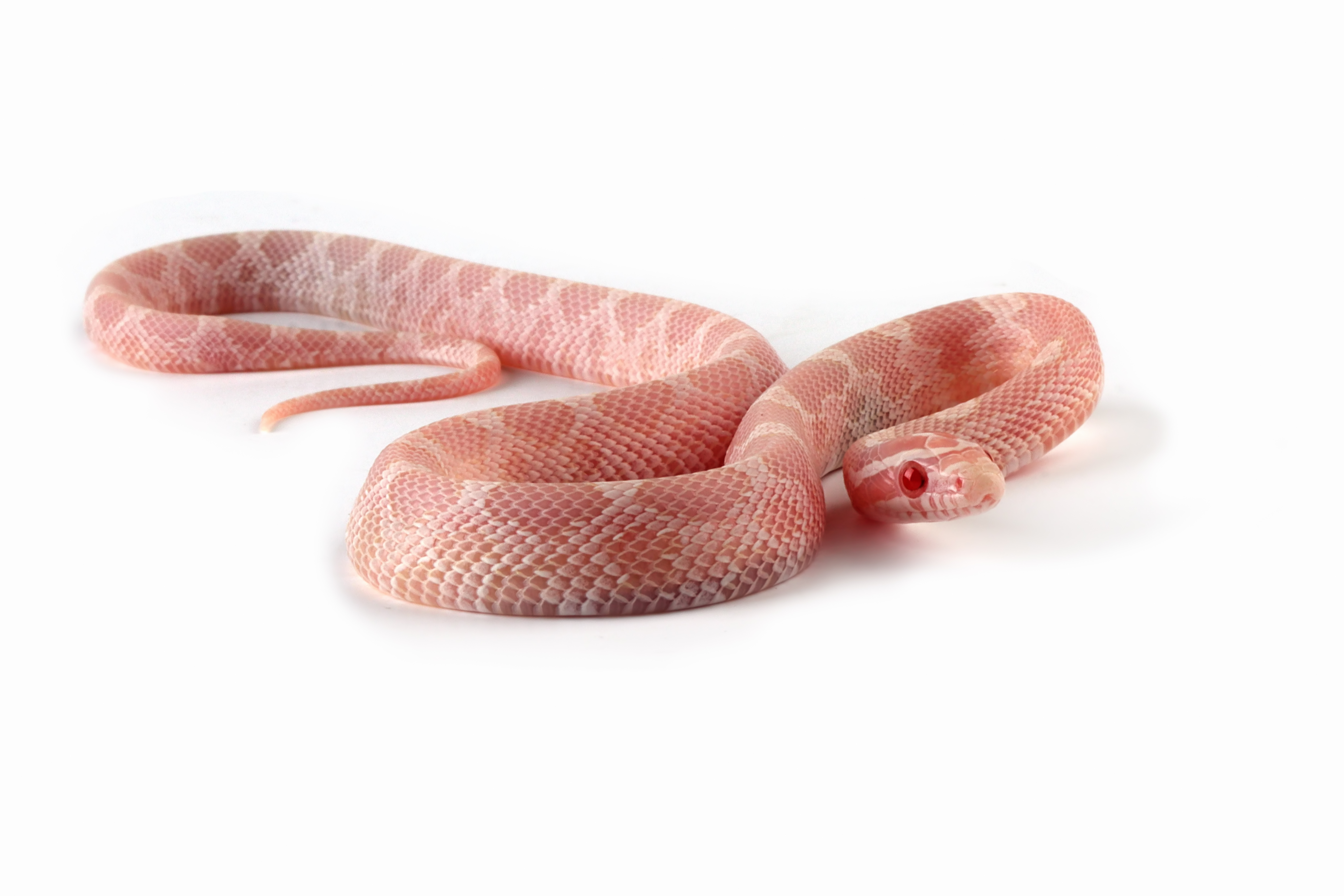
Milk, king, and corn snakes are carnivores, which means they eat small animals, typically rodents. Every snake is a little different when it comes to how often they eat, what type of prey they prefer, and how they respond to different feeding methods. What do milk, king, and corn snakes eat? Most snakes do well on a diet of appropriately sized frozen-thawed mice or rats, offered about once per week. As a general rule, the prey should be no larger than the widest part of your snake’s body.
Feeding tips:
- Use feeding tongs to offer prey safely
- Offer food during the evening, when your snake is naturally more active
- Avoid feeding live prey unless absolutely necessary, as it can injure your snake
- Try different prey types (mice vs. rats) or presentation styles (tongs vs. dish) if your snake refuses food
Note: All snakes sold at PetSmart are fed a diet of frozen-thawed rodents before going home.
Feeding frequency may vary:
- Hatchlings or juveniles: Every 5–7 days
- Adults: Every 7–10 days
- Snakes preparing to shed may skip meals for several weeks
Hydration and soaking Your snake should always have access to clean, fresh water. Choose a low, wide dish that allows your snake to both drink and soak. Replace water daily and clean the dish regularly to prevent bacterial growth.
Pro tip: Some snakes soak more during a shed cycle. Increased soaking is normal before or during shedding, but could also indicate high enclosure temps or mites—so monitor closely.
When to see a vet
In addition to regularly scheduled appointments, contact your reptile veterinarian if you notice the following signs:
- Hiding more than usual
- Eating or drinking less; weight loss
- Prolonged time refusing to feed (3 consecutive failed feedings)
- Swollen joints or reluctance to move
- Discharge from the eyes, nose or mouth
- Discolored skin
- Runny or decreased droppings
- Inability to open/close mouth
- Stuck shed covering the eyes
Go to “find a vet” on arav.org for help finding a reptile veterinarian in your area.
NOTE: Most, if not all, reptiles carry Salmonella bacteria in their intestinal tract and intermittently or continuously shed these bacteria in their feces, so they are unsuitable pets for very young children and those with compromised immune systems. Good hygiene must always be practiced around all reptiles, and hands should be washed before and after interacting with reptiles.
SHOPPING CHECKLIST
- well-ventilated 20-gallon terrarium (larger for adults)
- locking screened lid
- daytime heat lamp and bulb, and under-tank heat mat
- daytime fluorescent light and bulb
- habitat thermometers (2) and hygrometer
- misting bottle or automatic fogger
- humidity hut
- soaking tub
- reptile carpet, mat, or reptile-safe bedding
- artificial/natural rock or wood hiding spot
- branches for climbing and hiding
- large water dish
- frozen rodents and feeding tongs
Ready to learn more? This guide is a great starting place, but we encourage you to do more research on the individual species that you are keeping so that you can be as successful as possible! Related guides:
- Reptile & Amphibian Heating & Lighting
- Setting Up a Reptile or Amphibian Habitat
- Understanding Zoonotic Disease
FAQs
How often should I feed my milk, king, or corn snake?
Feeding frequency depends on your snake’s age and activity level.
Feeding frequency depends on your snake’s age and activity level.
- Hatchlings/juveniles: Every 5–7 days
- Adults: Every 7–10 days
- Before a shed: They may refuse food for 1–3 weeks
Always offer prey at night or in the early evening when they’re most active.
Why won’t my snake eat?
Colubrids are usually strong feeders, but appetite can drop due to:
Colubrids are usually strong feeders, but appetite can drop due to:
- Upcoming shed cycle
- Cool enclosure temperatures
- Stress from a recent move or habitat change
- Prey that’s too large or not warmed properly
If your snake refuses food three times in a row, consult a reptile vet.
Can I keep multiple colubrids together?
No. While corn, king, and milk snakes are generally docile, they are solitary and may become stressed or aggressive around other snakes. King snakes are known to eat other snakes, so always house them alone.
No. While corn, king, and milk snakes are generally docile, they are solitary and may become stressed or aggressive around other snakes. King snakes are known to eat other snakes, so always house them alone.
Do colubrids need UVB light?
UVB isn’t required but is recommended. A low-intensity UVB bulb over the warm side of the enclosure supports vitamin D3 synthesis and calcium metabolism, especially helpful for younger or growing snakes.
UVB isn’t required but is recommended. A low-intensity UVB bulb over the warm side of the enclosure supports vitamin D3 synthesis and calcium metabolism, especially helpful for younger or growing snakes.
What’s the best bedding for colubrids?
Use reptile-safe substrate like aspen shavings, coconut husk, or reptile carpet. Avoid cedar or pine, which are toxic. Bedding should be easy to spot-clean and replaced monthly.
Use reptile-safe substrate like aspen shavings, coconut husk, or reptile carpet. Avoid cedar or pine, which are toxic. Bedding should be easy to spot-clean and replaced monthly.
Do colubrids soak in water?
Yes. Many colubrids soak when preparing to shed or to help regulate their body temperature. Provide a shallow dish large enough for your snake to curl up in. If your snake is soaking excessively, check for mites or overheating.
Yes. Many colubrids soak when preparing to shed or to help regulate their body temperature. Provide a shallow dish large enough for your snake to curl up in. If your snake is soaking excessively, check for mites or overheating.
How can I help my snake shed properly?
Maintain proper humidity (30–50%) and offer a humidity hut or damp hide. Shedding typically completes in one continuous piece. If shed skin sticks, especially around the eyes (called "eye caps"), you may need to gently assist after a soak or consult a vet.
Maintain proper humidity (30–50%) and offer a humidity hut or damp hide. Shedding typically completes in one continuous piece. If shed skin sticks, especially around the eyes (called "eye caps"), you may need to gently assist after a soak or consult a vet.
How active are corn, king, and milk snakes?
Colubrids are generally active at night or during dusk/dawn. While not as high-climbing as arboreal species, they appreciate logs, hides, and textured surfaces to explore.
Colubrids are generally active at night or during dusk/dawn. While not as high-climbing as arboreal species, they appreciate logs, hides, and textured surfaces to explore.
Are colubrids good snakes for beginners?
Yes! Corn, king, and milk snakes are often recommended for new snake keepers due to their manageable size, hardy nature, and typically calm temperament, especially when handled gently and regularly.
Yes! Corn, king, and milk snakes are often recommended for new snake keepers due to their manageable size, hardy nature, and typically calm temperament, especially when handled gently and regularly.
What’s a common mistake first-time colubrid keepers make?
The most common issues include:
The most common issues include:
- Incorrect temperatures or humidity
- Feeding prey that’s too large
- Handling too soon after feeding
- Underestimating their ability to escape. Always secure the lid and monitor habitat conditions daily.
